Should you caulk the exterior before or after painting?
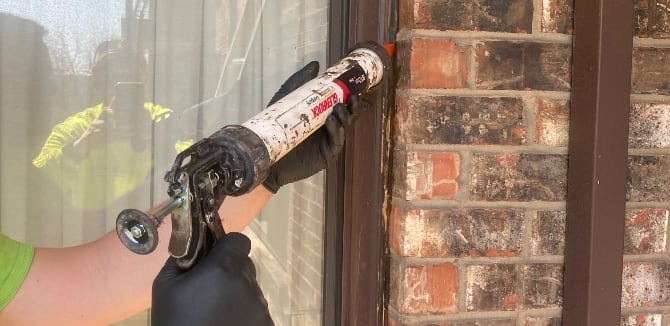
While a good paint job will add durability, age and the elements will eventually wear away at a structure until something has to be done, from minor repairs to complete rework. Part of every good paint job includes caulking, which helps to keep moisture and air out of seams, gaps and holes. “Should you caulk before or after painting?” It’s an important question because it is something that needs to be considered during a painting project.
Most painting contractors will caulk first, then paint. This creates a more seamless finish that is far more desired than bare caulk. However, there are situations where painters can choose to caulk after painting. We’ll go over this and much more in the following sections.
Check out the following to figure out which is best for you:
- What is caulk?
- Do you caulk or paint first?
- Why is it so important to caulk before exterior painting?
- Residential caulking before painting
- Commercial caulking before painting
- How to caulk the exterior to paint?
- How to choose the right caulk for your project
- Exterior caulking tips
- What types of repairs don’t require caulking?
- Is it better to DIY or hire a painting contractor to caulk?
- Choose exterior painting and caulking professionals in the Chicago area
- Frequently asked questions about caulking
What is caulk?
Caulk is a flexible material used to seal joints and seams. It was originally made of fibrous materials and used almost exclusively in boats to waterproof hulls. It was also used early on in cast iron sewage pipes. The caulk we all know today is made of a variety of compounds but the most often used is acrylic latex caulk, which is durable and easy to work with. There is also silicon-based caulk that offers water, mold and mildew-resistant qualities.
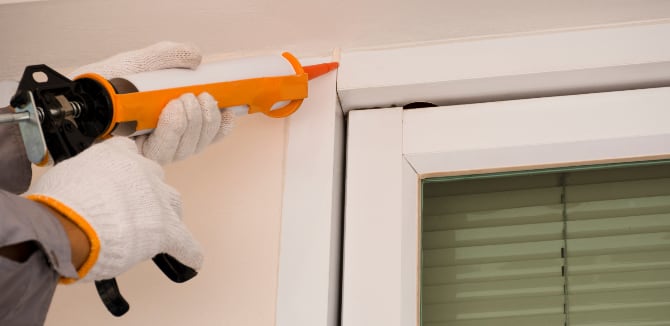
Applied with a caulking gun, the substance will blend in seamlessly when used by a professional. But before the new caulk is installed, the old caulk has to be removed if the seal is going to be tight. As caulk ages, it dries, cracks and needs to be removed. The new caulk will shrink a bit as it dries (which is why it’s always important to let it fully dry before painting over it), but it forms a seal that will keep moisture out and make structures more air tight and durable.
- Silicone
- Polyurethane
- Water-based foams
- Butyl rubber
- Latex
- Oil
- Resin
Do you caulk or paint first?
A frequent and important question painting contractors get is “do you caulk or paint first?” The answer is that it depends on the situation. During most projects, contractors will prefer to apply the caulk before painting if the caulk line is going to be noticeable when the work is completed. But caulk can be applied after painting if it is hidden.
Caulk is commonly applied to areas around windows to keep them air tight, but it’s also used around doors and baseboards. These are usually highly visible areas, which means you will want the caulk applied prior to painting so the caulk can be covered by the paint and blend more seamlessly. But again, the caulk before or after the painting debate is something every experienced paint contractor knows about and will know how to approach individual situations.
Why is it so important to caulk before exterior painting?
Cracks and gaps can be perfectly sealed by caulk. These areas are at risk of moisture intrusion, even if the gap or crack is a hairline in size. On exterior surfaces that are to be painted, the best approach is to fill the gaps with caulk prior to painting. Having the caulk and paint covering the cracks or gaps, no moisture will be able to penetrate the surface and cause the paint to peel or the materials under it to rot.
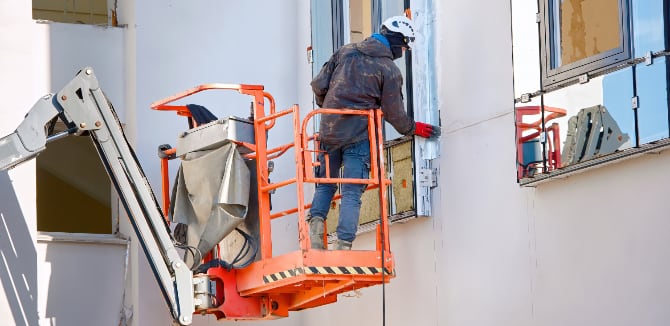
Another reason it is important to apply caulking before painting exteriors is that it can reduce drafty interiors. Drafty spaces aren’t comfortable to work or live in, and there is also the utility bill to consider – when air-conditioned air is allowed to escape, it negatively impacts the efficiency of appliances and results in higher bills.
Caulk is almost always applied with a caulk gun, but there are many different types of caulk that are made for specific purposes and for application on a variety of different materials. For example, caulk used in a shower will differ from caulk used around exterior doors and windows.
Caulk made for exterior surfaces is an important component of any painting job, as it will improve the look of a finished paint job while adding protection and insulating properties.
The following are reasons caulk is an important component for exterior jobs:
- To improve energy efficiency
- Prevents condensation problems
- Improves final painting appearance
- Keeps water/moisture out of seams and gaps
- Prevents pests, such as insects, from getting into walls
- Insulates from extreme elements
- Fills nail holes to prevent rust and rot
Residential and commercial exterior caulking
Exterior caulking, often made with silicone or polyurethane, brings a host of benefits for exterior work. While the application of caulk is fairly straightforward, it needs to be applied with some attention to detail, as any gaps between caulk will allow moisture and air to leak in, potentially causing problems that can go unnoticed for a long time and result in extensive damage. That’s why painting contractors offer exterior caulking services.
In areas where the caulk will be applied and not covered by paint, contractors make sure they choose a colored caulk that blends in with the surrounding areas. By some estimates, there are more than 200 colors of caulk from which to choose. A quality contractor will weigh all the options available and choose the best ones.
Residential caulking before painting
Residential caulking services are an important aspect of any residential painting job. Common areas where caulk is essential include vents, doors, windows, skylights and any other area where a gap exists and needs to be protected from wind, moisture and pests. Caulking before painting exterior surfaces is one of the most common approaches, as this will ensure a better aesthetic in the end.
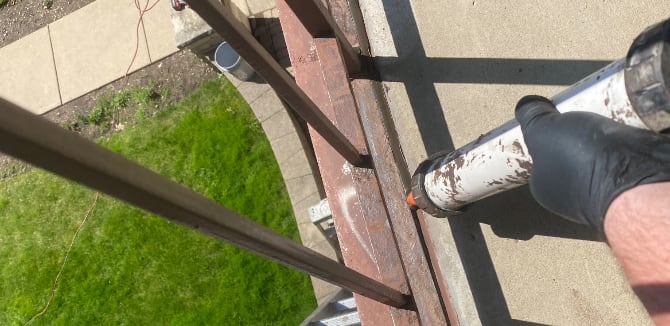
Whether it’s a seam, nail hole, small gap or crack, caulking provides the protection that all structures require to one degree or another. In the hands of a professional, the application of caulk will enhance the outcome of any painting job.
Benefits of residential exterior caulking
Exterior caulking for residential projects is almost always one of the first steps of a painting job. Professional painters know where to look and what to look for, identifying all areas that require caulk. They also know exactly what type of caulk to use on exterior surfaces.
The following are the most often cited benefits of exterior caulking:
- Prevents pest infestation
- Improves a home’s curb appeal
- Reduces erosion risk
- Prevents water damage
- Reduces utility bills
- Can prevent health risks
At Painters Inc., our clients get every advantage possible out of every type of caulk we use over the course of the project.
Commercial caulking before painting
Commercial caulking is just as crucial on commercial painting projects as it is on residential projects. Caulking before painting exterior commercial surfaces is one of the first phases of a project and it’s an important one, as caulk provides a host of benefits, not the least of which is keeping potentially damaging moisture out of cracks, seams and gaps.
There is also a visual element to consider – caulk is used to hide irregularities on surfaces, producing a seamless appearance. Caulk is a relatively inexpensive material, which makes it a cost-effective tool for keeping energy bills lower and reducing the risk of damage due to moisture rot or pests.
Benefits of commercial exterior caulking
Exterior caulking on commercial structures prevents costly problems from occurring, which is why every quality painting contractor will look for areas that need caulk. When this crucial step is skipped or poorly done, there will be problems related to moisture, such as mildew, mold and rot. Furthermore, caulk around the exterior of windows can keep air from creating a drafty interior. Caulk also prevents surface erosion, which is something that can occur around decks and patios that aren’t sealed correctly.
At Painters Inc, our approach to every job is to go down our checklist of items that account for everything that makes a job a success, and identifying areas that need to be sealed with caulk is one of the first items on the list. We know what type of caulk to use on every type of surface and our professional painters know how to apply it and whether it should be applied before or after the paint.
How to caulk the exterior to paint?
Professional painters with plenty of experience know exactly how to caulk exterior surfaces where there are seams, cracks, holes and gaps. Most professionals follow the same steps, which are as follows:
Get the best quality caulk
There is more than just one type of caulk, as different surfaces will require specific types. There is also a difference in the quality of caulk, which is why it’s important to work with a contractor that doesn’t cut corners with inexpensive, low-quality materials. Some caulk manufacturers make a product with an astounding 40-year warranty on it. The best contractors only use materials that are durable, look great and last a long, long time.
Clean the exterior area of any dust and debris
Caulk does its job best when applied to clean surfaces. Quality painting contractors make the cleaning process an integral part of the project, thoroughly removing all dust and debris that could compromise the outcome of the job. This cleaning process can include bringing in a power washer to get rid of the most stubborn stains, debris and organic growth like mold and mildew.
Apply caulk to high-risk areas
On areas of a structure that are at greater risk of damage from the elements, caulk adds an extra layer of protection. For example, nail holes need to be filled, as these areas are prone to moisture damage, including rusting nails that streak surfaces and rotting wood. Caulk is also essential around garage doors, windows, butt joints and door frames. New wood, such as areas that have recently been repaired, is also important to protect with caulk.
Paint with primer (if necessary)
There are times when painters need to lay down a coat of primer prior to painting, and there are some caulks that require priming before they can be painted. Fortunately, most caulk on the market today is able to be painted without primer.
Dry the caulk
Caulk will change in shape a slight bit as it transforms from new and wet caulk to dried/cured caulk. It’s important to wait until it is fully dry before painting over it, as the paint could otherwise crack or distort as the caulk dries.
Use the right caulk type for each exterior material
Latex caulk is what painters use when they know they will be painting over it. However, areas around windows and door frames, which require a clear drying caulk, painters will use silicone, which is a type of caulk that cannot be painted over. These details are ironed out during the planning phase of the project, as there will be situations where the paint will come before the caulk.
When you partner with a quality painting contractor, they will know everything they could possibly need to know about caulk, including which kind should be used, where it needs to be applied and whether it should go down before or after painting.
How to choose the right caulk for your project
To know how to choose a caulk that works for you takes knowing what type of surface it will be applied to. For example, if you’re caulking around wood, you’ll need to choose a type that will work with wood. If you’re caulking around tile, you’ll need to choose a caulk made for that type of material. When Painters Inc. is painting the exterior of a home and the gutters need to be caulked, there is a special caulk made specifically for gutters that we will use.
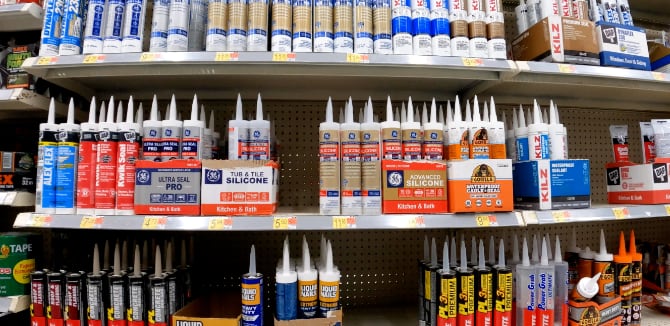
You also need to consider if you will be painting over the caulk, because caulk made with silicone does not provide a suitable adherable surface, which is why it needs to be primed before being painted. However, the most common type of caulk – latex acrylic – can be painted over when properly dried.
Choosing the best exterior caulk for your commercial building
To ensure your paint job lasts a long time and you get the most protection possible, it’s crucial to use the best caulking on your commercial building. Sealing off gaps and cracks is what exterior caulk is used for, but you have to use quality caulk to get the expected results. Using low-quality caulk will result in the gaps becoming at risk from moisture damage and damage related to pest infestation.
Due to silicone’s durability in the outdoor setting and because it has excellent waterproofing abilities, it is one of the most common types of exterior caulk used today. Silicone can last 20 years or longer. Keep in mind that if you’re painting over silicone, you’ll need to put down a coat of primer first so the paint will adhere properly.
Another type of caulk used in exterior projects is polyurethane caulk. This type of caulk is known for its resistance to corrosion, chemicals and moisture. One advantage to using polyurethane caulk is that it will bend without cracking, which is important in situations where expansion and contraction are common. Most polyurethane caulk products will last around 10 years.
Exterior caulking tips
One thing you will want to discuss with your contractor prior to them starting the project regards exterior caulking tips. While they are the experts, you should inquire about what areas of the house need to be covered.
Caulk nail head holes
When you want to get the best possible look out of your painting project, it’s important that all surfaces appear uniform, level and consistent. Nail holes can prevent this from happening, which is why quality painters will take caulking holes quite seriously. Not only does this improve the appearance, it also prevents the nails from coming into contact with moisture and causing damage.
Caulk fascia seams
Fascia, which is the band of material under the edge of the roof, should always be caulked. Caulking fascia seams will ensure that no moisture, debris or air gets into the gaps. And while this type of protection is important, caulk will also fill the gaps and help to create a more uniform appearance that adds curb appeal to the home.
Caulk around windows
Caulking exterior trim, such as the trim around windows, is a standard operating procedure with painting projects. Caulking around windows helps to keep moisture out and creates a tight seal that keeps the interiors from becoming drafty. Should a window become foggy and condensation build up on the panes, it’s a sign that the seams were not caulked or were caulked incorrectly.
Caulk door frames
Exterior door caulking is an integral part of the painting process. Caulking door frames prevents wind and moisture from coming through the seams between the door and surrounding materials. While moisture can eventually rot out the wood around the door, the air getting through will lead to higher utility bills and less comfort, which is why ensuring the caulk is properly applied and maintained is so important.
Caulk stucco cracks
Polyurethane-based caulk works well on stucco. Stucco has a tendency to break down with age, which is why caulking stucco cracks is common in painting projects on this type of surface. Painters Inc. has worked on many stucco homes and commercial facilities and knows exactly how to make repairs so the project outcomes are second to none.
Caulk siding
Exterior siding caulk, which is usually made with silicone, is used around trim areas so all exposed joints are sealed. When the silicone is fully dried, it can be primed and painted.
Bringing in a trusted and experienced painting contractor will ensure that all the different types of caulk required are applied correctly and will last a long time. Whether the surfaces are stucco or vinyl siding, wood or cement, Painters Inc. will seal all the gaps with quality caulk.
What types of repairs don’t require caulking?
While caulking is used in many, many situations, there are jobs that will not be suitable for caulk – usually ones where the gap in a seam is more than a quarter inch. This type of seam will require repairs that are beyond what caulk can do.
Large repairs that caulking typically won’t handle include:
- Damaged materials, such as rotted wood
- Seams, gaps or holes larger than .25 inch
- Butt joints on cedar
- Garage doors
Is it better to DIY or hire a painting contractor to caulk?
DIY caulking, which at the most basic levels is probably not something most people are going to do wrong, should only be something a novice should do on the smallest jobs and perhaps even as a quick fix before a contractor comes in to do their work.
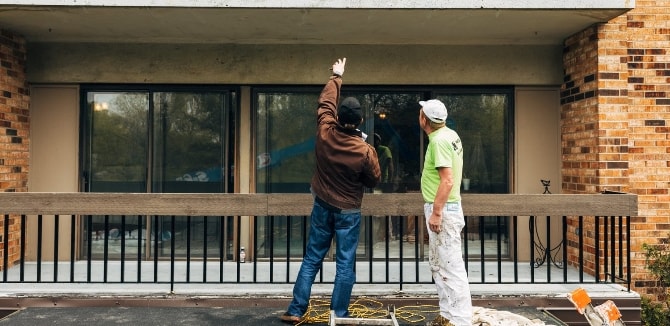
Exterior caulking contractors, which are also painting contractors, know exactly how to use caulk on any type of surface and they also know how to paint over it (or not paint over it depending on the type of caulk). If you have the slightest doubt about what type of caulk to use or how to apply it, hire a painting contractor to do it for you.
If you know there are gaps in your building you don’t feel comfortable accomplishing yourself, it’s always best to bring in a professional. In most instances, it’s best to have an exterior painting company come out and give you a quote that includes the list of repairs needed. That way, they can handle the tough work and you can sit back and relax.
Choose exterior painting and caulking professionals in the Chicago area
Exterior painters in Chicago are also exterior caulking contractors, as just about every painting job requires caulk and they will have applied hundreds of tubes of the material on surfaces of all types. Caulking and painting go hand-in-hand and the most trusted contractors will bring the right materials to the job.
At Painters Inc., our professional paint experts are here to assist in all types of painting projects that include exterior caulking expertise. There are many, many types of caulk and more than 200 colors on the market today, which means there is one every type of situation, from siding to windows, decks to butt joints and doors. You can count on our expertise, so contact us and let’s discuss your project.
Frequently asked questions about caulking
Every painting project, whether it’s residential or commercial, comes with many questions that need to be answered. For those unfamiliar with all the different types of caulk and all the areas of a structure that they are required, the questions can range from the safety of the product to how long it takes to dry. We’ve got some of the most common questions and answers below:
Is it safe to paint over caulk?
Just about every type of caulk can be painted over. Some (silicone-based caulk) require a primer before paint. In any situation, the caulk needs to be fully dried before it can be painted over. In most situations, the painting job looks better when the caulk has been painted over.
What is the best time for exterior caulking?
Exterior caulking is almost always applied right after the surfaces have been cleaned, repaired and primed. As for timing related to weather, it’s not advisable to apply it in cold weather. Rather, contractors will caulk gaps, cracks and holes on warmer days and when the air isn’t too humid.
How long does caulk take to dry?
While there are many different types of caulk made from different materials, almost all of the products on the market today will dry within 24 hours of application. Warmer weather speeds up the drying time. Some latex acrylic caulks dry within 30 minutes, while others might take days to dry.
Your contractor will know the dry times for all the caulk they use and plan accordingly. Painters know to never paint over wet caulk, as that can result in damage to the paint.
How long does caulking last?
Silicone is very durable and can last on average around 20 years. Polyurethane caulk will last between 5 and 10 years. Latex acrylic caulk has a projected life of around 10 years. Quality painters know to remove old caulk during their painting projects and replace it with new caulk.
What is the longest-lasting exterior caulk?
Silicone has the durability that most other caulks do not possess, which is how it will last around 20 years. There is a pure silicone caulk on the market that has a 40-year warranty and is aptly named Merit Max Siliconized 40-Year Caulk.
Is caulk waterproof?
If caulk has one job, it’s to keep water out, so every type of caulk on the market is designed to be waterproof. However, silicone caulk, which is considered “fully waterproof,” is used almost exclusively in the areas that are most prone to moisture, including bathrooms and kitchens.
Which is better: latex caulking or silicone?
Latex caulking or silicone caulking are both extremely popular choices and are used in just about every painting job. The question of which is better depends on what type of surface is being addressed. Your painting contractor will most likely use silicone in the bathroom, kitchen and in many exterior areas, whereas they will likely choose a latex acrylic caulk for other areas, such as around windows, doors and trim.
Can you paint over silicone?
When a silicone caulk is mixed with acrylic, it can be primed and painted. However, pure silicone caulk should never be painted because the silicone will repel the paint and it won’t adhere. In any situation where caulk is being painted, it must be completely dry before any paint is applied.









